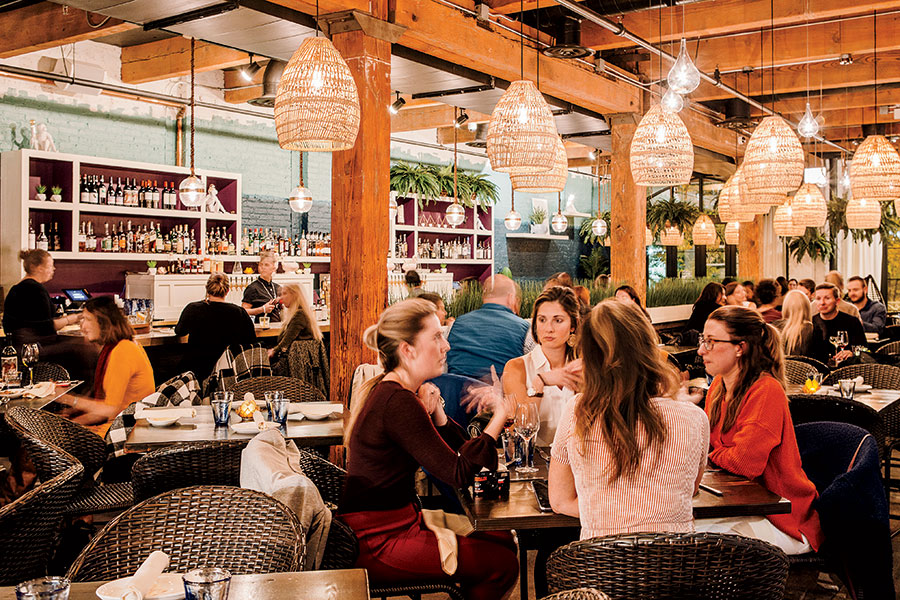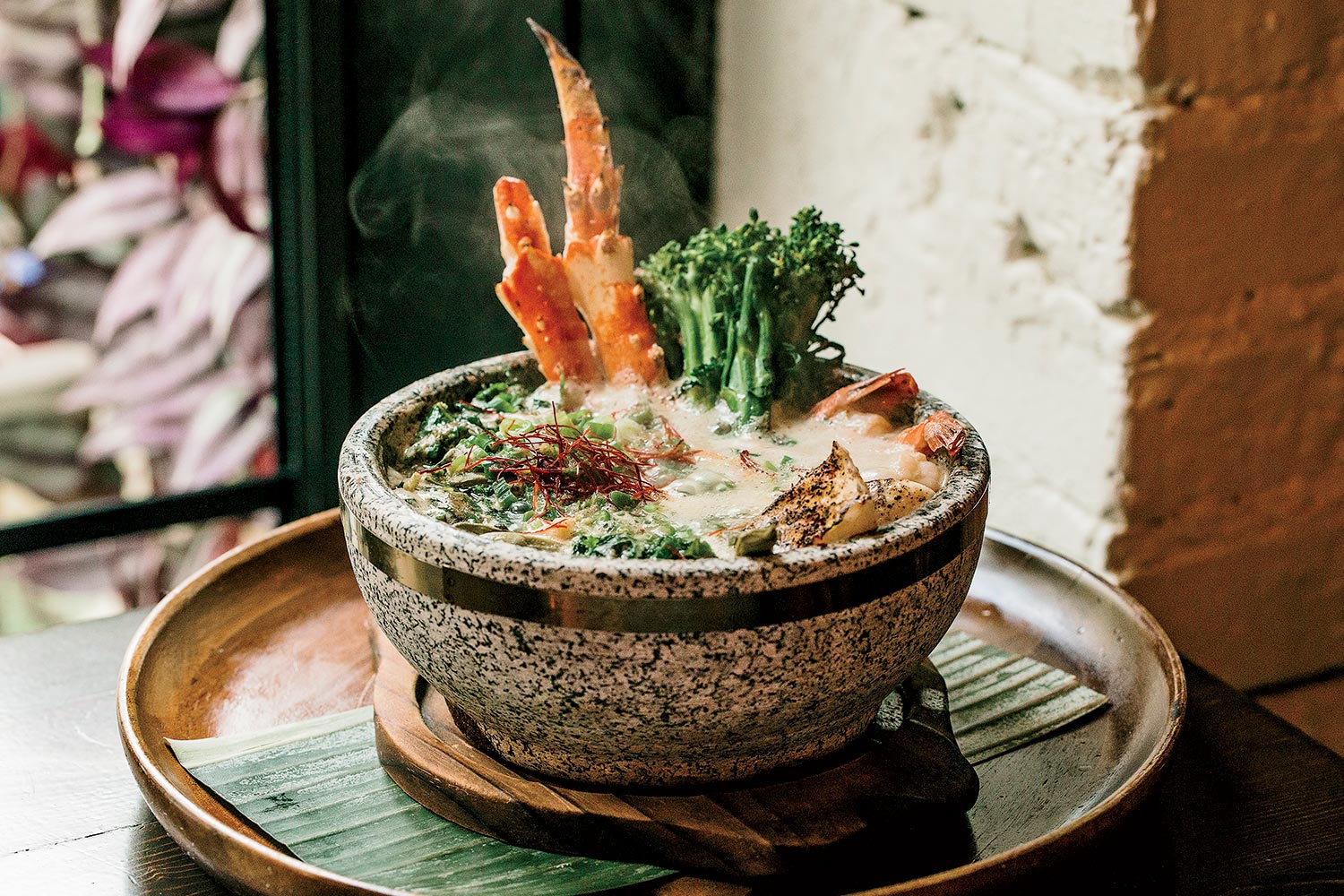I’ve been trying to get my head around Flora Fauna for weeks now. The menu is all over the place — elote cakes here, jerk pork shank fried rice there — and the website name-checks more countries than a Eurailing college junior. The loft-like space, most recently home to Bohemian House, has been transformed into a plant-filled tropical fantasia with sea-toned walls, leaf-printed banquettes, mother-of-pearl tiles, and some kind of dangling monkey lamp. It looks like Fantasy Island on an acid trip.
Then there’s the location. Despite a recent residential boom, River North still feels less like a neighborhood than an expense account with its own ZIP code. Surrounded by polished hotels and touristy cantinas, a restaurant populated with young diners sipping yuzu daiquiris and splitting roasted baby yams just seems out of place. Jonathan Meyer, Flora Fauna’s executive chef and co-owner, calls the five-month-old spot “a New American bar and restaurant with heavy influences from equatorial cuisine,” which doesn’t exactly clear things up. Nor did a preview item in Eater in which Liz Pearce, Meyer’s spouse and Flora Fauna’s beverage director and co-owner, described the menu as the “world’s cuisines greatest hits.”
Wait a minute. This all sounds just like — oh gosh, it is. Fusion! I didn’t know that was still a thing. In the ’90s and aughts, we saw basically every possible combination of cuisines until the whole trend became senseless and terrible and turned into a lowest-common-denominator joke involving bacon milkshakes and ramen burgers. Yet here’s Flora Fauna, blithely mixing cultures at the exact moment in time that everyone else seems to be digging deep into hyper-traditional, über-authentic cooking. On my visits, I played a game that involved gazing around the room and trying to match the interesting-looking food I was seeing on other people’s tables with the dishes described on the menu. I lost repeatedly.
But the first hint that the restaurant may be more than an anachronistic gimmick arrived in a play on chilled Thai som tam salad. After blanching shredded green papaya to al dente, per tradition, Meyer (the former chef of Broken Shaker in the Freehand Hotel) tossed it with Sichuan dan dan spices to bring the heat and Costa Rican jackfruit to impart a grape-like sweetness that dovetailed with the crushed cashews and scallions. It’s a ridiculous mash-up that also happens to be inspired — equal parts refreshing and intense.
The kitchen goes even further with the elote cakes, which feature influences from multiple continents tossed (metaphorically, at least) into a blender. Crisp polenta squares were anchored to the plate with Japanese Kewpie mayo, topped with smoky grilled sweet corn reminiscent of Mexican esquites, and drizzled with a chile-spiked honey generally found with Puerto Rican sorullitos. Inexplicably, the flavors balanced out and the polenta stayed creamy inside. Then there was the surprisingly meaty quail with spicy pickled cauliflower and cucumbers, a play on the Haitian braised pork dish griot and pikliz. Meyer glazed the quail in a sticky tamarind sauce, adding a layer of sweet tartness.

Soon my group was dipping panko-fried mushrooms into pineapple-rum mustard and snapping off pieces of a hulking seafood fritter to submerge in a Kerala curry thickened and soothed with whipped coconut cream. I’m a sucker for a crunchy-creamy-sweet-salty thing, and the kitchen worked that angle in ways I rarely expected.
Meyer is among the first chefs in Chicago to do koji-cured steaks, and he does them well. Koji is Japanese rice that’s been fermented with the same fungus used to make soy sauce; Meyer’s team sprinkles the rice over prime rib eye and places the beef on a wire rack in a cooler for five to seven days. After a simple rub of salt and pepper and a short sizzle on the grill, the meat tasted decadent and nutty, like it had been dry-aging for a month. The steak came with golden yucca tots, and the drizzle of garlicky, savory vinaigrette soaking into them pushed the whole thing over the top. By this point in the meal, the idea of American beef with a Japanese preparation and a Costa Rican side dish didn’t feel the slightest bit odd, and I was ready to embrace any combination Meyer threw at me.
But then the jerk pork shank fried rice arrived. It was a cloying, egg-mush fiasco. There were other head-scratchers as well, like a stone bowl filled with a ramen-type broth loaded with prawns, crab legs, nopales, panela, and scallions, a dish that split the difference between a Chinese hot pot and a Mexican molcajete. You’re meant to pluck items from the soup and fold them into warm tortillas, which promptly turned the whole operation into wet, muddled nonsense. Similarly, a rococo dessert of tres leches cake with strawberry-infused coconut milk, roasted pineapple, and a sawdust-like layer of dried coconut delivered nothing but spongy, saccharine sadness. And the mix-and-match cocktail program, meant to give imbibers more control, is good in theory, but in practice adding tangerine-grapefruit Campari to a whiskey sour sounds more like a threat than a drink.
Despite its flaws, I find myself wanting to go back to Flora Fauna. The inspiration coming from the open kitchen creates a weird energy that keeps diners off-kilter and absorbed in what’s coming next. Plenty of chefs exhibit a wide knowledge of global ingredients, but Meyer’s ability to make unexpected connections — such as using the chayote he recalled from Costa Rican pig roasts as an accompaniment for fingerling potatoes — creates memorable moments. Even when dishes miss their mark, there’s the sense that Meyer’s ideas come from a place of respect for the cuisines, rather than being a lazy pastiche. Is it fusion? I’m not sure it even matters.




